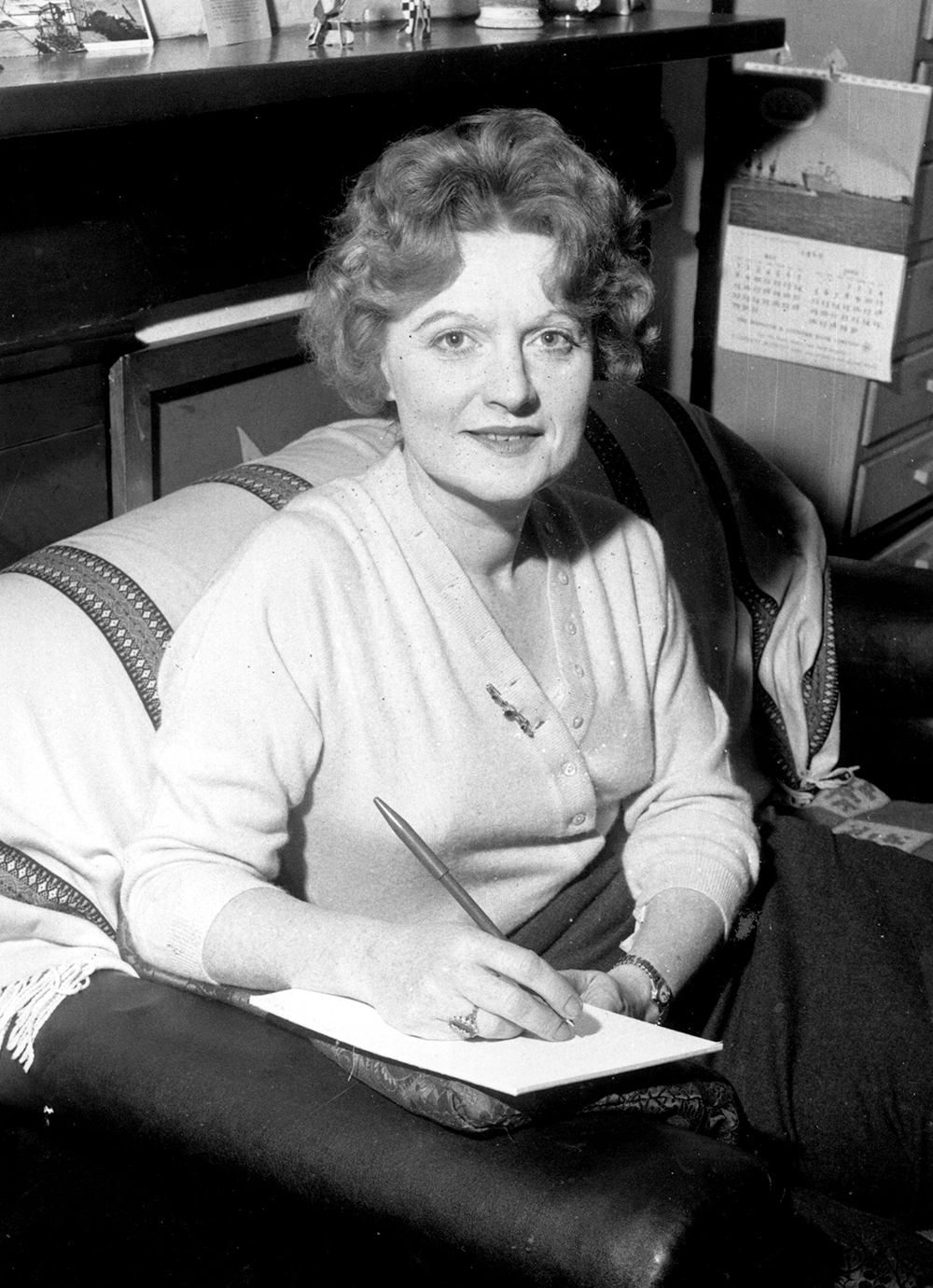
In 1995, Dame Muriel Spark, then one of Britain’s most distinguished living writers, was interviewed for a BBC documentary. During filming, the show’s editor commented that ‘her biographer must be the most depressed man in England’. Three years earlier, Spark had personally anointed Martin Stannard as the writer of what she intended to be the authorised version of her life, presenting him with the vast archive of documentation – spanning 50 years and 50 metres – gathered at her home in Arezzo. ‘Treat me as if I were dead,’ she instructed him.
Stannard understood this to mean that he should proceed as a traditional historian; by the time his hag-ridden book was published 17 years later he had learned his mistake. The construction of biography assumes a certain orderliness in its subjects, the author’s task being to summarise, arrange and analyse the facts of their existence; but Spark had never been much interested in doing anything so ordinary as living. Hers was not so much a life as a plot, and Stannard, unwittingly, was written into it.
Frances Wilson is a ferociously clever writer, and with Spark as her subject she needs to be. Taking Spark’s feud with Stannard as its catalyst, her biography of ‘the loneliest and most singular figure on the 20th-century literary landscape’ grapples with the process by which Muriel Spark created her greatest work of art, ‘Muriel Spark’; a writer who in a (discarded) author’s note on her most celebrated novel The Prime of Miss Jean Brodie (1961) declared: ‘It has always been my intention to practise the arts of pretence and counterfeit on the reader.’
The result is a revolutionary book. When Spark published her first novel, The Comforters, in 1957, it was recognised as unique – something that quite simply had never been done before. Wilson’s achievement in Electric Spark is equally remarkable: an entirely original method of life writing which leaves conventional biographical techniques gasping in the dust.
The focus is on the first 39 years of Spark’s life, particularly the ten postwar years she spent on the rackety fringes of literary London, during which she produced biographies of Mary Shelley and John Masefield and edited the poems and letters of the Brontës. Of her 22 novels, it draws mainly on the first six, then the quartet set in the 1940s and 1950s and the final two, Aiding and Abetting and The Finishing School.
‘It has always been my intention to practise the arts of pretence and counterfeit on the reader’
The fiction, Wilson suggests, needs to be read diachronically, as an evolving, coherent single work, which encompasses, from The Comforters to the last line of The Finishing School (‘As we go through the evening and into the night’), the span of a single day. If, as she observes, there can be no word for Spark’s style other than ‘Sparkian’, a technical comparison might be made with Proust’s investigation of the hypermnesic qualities of memory, whereby certain recollections remain supervivid, producing remembrances in which all moments are simultaneously co-present. Hence, Wilson suggests, the ‘quantum’ quality of Spark’s fiction – her apparently slight novels are infinitely larger on the inside.
Muriel Camberg was born to lower-middle class Jewish parents in Edinburgh in 1918. Though her literary talent was evident early (she effortlessly won every writing competition she entered), her family could not afford university. So, after leaving James Gillespie’s school in 1935, she trained as a secretary before finding work as the assistant to the owner of a smart department store on Princes Street.
In August 1937 she travelled alone to Cape Town to join Sydney Oswald Spark, who had promised her a comfortable life in what was then southern Rhodesia. The new Mrs Spark was unaware that Ossie, as he was known, was emigrating because he suffered from fits of severe manic paranoia which left him unable to hold down a job in Edinburgh. Her husband’s illness began to manifest itself shortly after the birth of their son Robin in 1938, when Ossie took to firing a pistol in the house.
Spark was disgusted by the provincial attitudes and vicious racism she encountered in Rhodesia, which she mercilessly exposed in future short stories. But at this juncture she was exhausted and depressed, living in a squalid house with no electricity or running water and trying to protect her baby from a man who had been dismissed from his teaching post for beating a pupil almost to death. Escape seemed impossible. Ossie’s mental instability was insufficient ground for divorce, and war had been declared in Europe.
Spark eventually arrived in London in 1943, after a lost two years during which Wilson makes a convincing case for her having worked for British Intelligence. She had chosen desertion over the possibility of death at her husband’s hands, which meant that Ossie was automatically granted custody of their child. Later, when she was famous, Spark’s publicly cruel treatment of Robin – ‘He’s never done anything for me except being one big bore’ – became part of her persona as a ruthless artistic monster. In fact she contested the custody ruling for a decade and spent much of her life struggling to support her son financially. It was Robin’s insistence on their shared Jewish heritage which ultimately provoked the rift; but Wilson is enlightening on the ‘domestic savagery’ required of the artist, always more forgivable in men.
Installed at the Helena Club in Kensington, an establishment for ‘Ladies from Good Families of Modest Means who are Obliged to Pursue Occupation in London’, Spark took advantage of the wartime blurring of social divides to hoick herself a few rungs up the class ladder and spent six months employed in black propaganda at Milton Bryan. The atmosphere was at once anarchic and surreal, which confirmed her obsession with codes, secrets and the deadly potential of the fictional.
In 1947, Spark accepted the post of general secretary at the Poetry Society, where she was swiftly appointed editor of its Poetry Review. The magazine officially deplored the ‘morbid tendency’ of contemporary poetry, but Spark had no truck with art as moral uplift. Poetry, she asserted, had better things to do than be a ‘baby’s comforter’. Five visionary, transformative editions followed, as did a wave of infuriated resignations. Spark held out for dismissal, in order to claim her severance pay, before embarking on a period of almost aggressive productivity. (Wilson’s depiction of Spark’s lifelong ballsiness when it came to dealing with exploitative editors and publishers will have any professional punching the air.)
Her conversion to Catholicism in 1954 marked a ‘species change’, releasing her from a series of entanglements with quite staggeringly mediocre men and annealing a commitment to her art which was not necessarily benevolent: in her story ‘Portobello Road’, the ghost of Needle – who has, naturally, been murdered in a haystack – says of writing:
When I failed again and again to reproduce life in some satisfactory and perfect form… in my impotence… I secreted a venom which infected all my life for days on end and which spurted out indiscriminately… on anyone who crossed my path.
This much, however, is mere chronology, which both Wilson and her subject acknowledge as a vulgarity. As the essential subject of Proust’s In Search of Lost Time is ‘the inner book of unknown signs’, the only volume ‘whose impression has been made by reality itself’, Electric Spark is a deceptively supple, astonishingly rigorous investigation of the nature of the truth in art. Wilson’s prose darts and spins so elegantly that the sheer pleasure of the narrative almost conceals its purpose, which is not a revision of Spark’s legacy (although this is done brilliantly) but a portrait of a consciousness in its entirety, stripped down to the brain.
Spark’s eerie foresight, her conviction that she was a magnet for the experiences which alchemised in her art, is perfectly mirrored by Wilson’s radical approach. Electric Spark heaves with ghosts and furies, burglaries and blackmail. It is disquieting and absolutely mesmerising. I was possessed by this book in the same way that I suspect its author was possessed by Spark. It still hasn’t put me down.








Comments